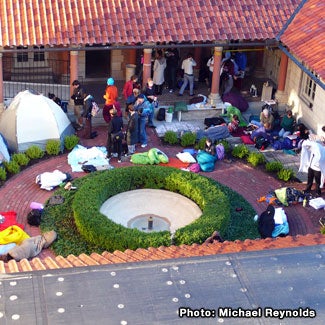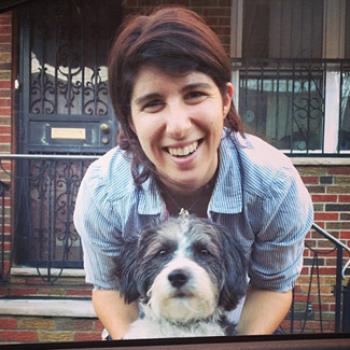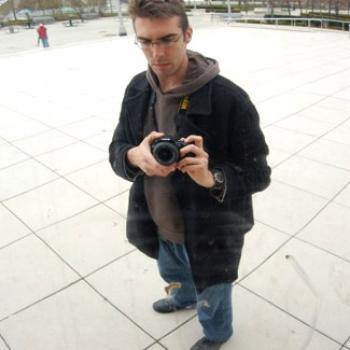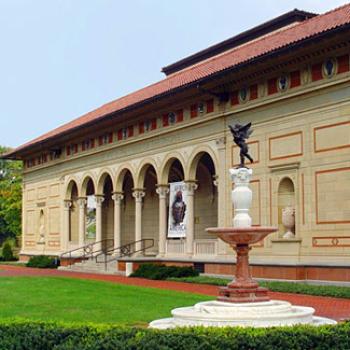On the art rental program
Prof. Erik Inglis ’89
“All those students lined up for art rental aren’t just waiting patiently in a line; they’re also actively teaching each other and learning from each other, sharing their enthusiasms and gaining new ones.”

I often turn to the Allen Memorial Art Museum’s Art Rental program when asked to explain Oberlin, and not just because I teach art history. For me, both the goal and the process are important. The goal, of course, is clearest: getting a great piece of original art to hang in your own room for a semester. There are two parts of that statement worth noting. First, “great art"; that’s not mere puffery. While the works in the rental collection are distinct from the permanent collection, the rental collection is not a lesser category. In fact, over the last several decades, close to fifty works have actually migrated from the rental collection into the Museum’s permanent collection - enough to make a fine exhibition of their own. For example, if you were a student in the 70s, you might have rented Roy Lichtenstein’s “Crying Girl;" if you were here in the 90s, you might have spent a semester with Cindy Sherman’s “Untitled (Portrait of Mother, Son and Daughter).” Students today frequently find these works displayed on the Allen’s walls, alongside other important works by these artists. This movement from one collection to the other demonstrates just how wisely and ambitiously the Museum’s curators have built the rental collection. Working with a limited budget, they have exercised exceptional judgment to identify modestly-priced works that promise enduring rewards to their viewers. They have recognized high-quality art years and sometimes decades before the rest of the art world catches on. And, when these works move into the permanent collection, they are replaced in the rental collection with similarly ambitious work by other artists. Thus, one enjoyable way of looking at the current works for rent is to speculate about which works might one day move to the permanent collection.
The second part of the goal of art rental is to spend time with the work of art. Ellen Johnson invented the program because she knew that prolonged inquiry and investigation are essential; living with one work of art for three months is a different experience than quickly visiting dozens in a museum, or surfing digital reproductions online. That emphasis on direct, deep and lived experience is shared across Oberlin’s curriculum. From the chemistry labs to the dance studios, from the Conservatory to the Center for Service and Learning, an Oberlin education is not a vicarious experience of watching others from a distance. Instead, it is an engaged, first-hand experience. Learning by doing, your studies become a part of your life, instead of apart from your life.
That emphasis on the engaged experience brings me to the process of art rental, for the process also speaks to Oberlin’s values. I see that process at work twice year, when getting to my office in the courtyard behind the Museum becomes an obstacle course requiring me to wade through (and sometimes step over) the sleepy throng. It requires enthusiasm and commitment to spend the night waiting for the worthy goal. In the spring semester, snowy nights sometimes force students into the Clarence Ward wing of the Art Building, with the occasional tent popping up in a classroom. Caring for the piece demands responsibility; non-Oberlinians always ask about damage, and are always surprised to hear that it is all but non-existent. And what consistently impresses me most about art rental is that very often most of the students in the line are new to me. This is significant, because at other colleges art rental would only interest art students, and an art professor would know them all already. At Oberlin, on the other hand, everyone’s interested in art rental. And that’s not just because they see art as particularly significant; it is because, as Connie Schultz, a recent commencement speaker, put it, “Oberlin cares about everything.”
It’s great fun to teach at a college where students care about everything, are ready to hear you out about why your field matters, and what matters in your field. I think it’s even better to be a student at a college where your peers care about everything. There are two great benefits to this atmosphere. First, it means that if you are passionate about something, your peers will understand and support that passion. Whether it’s John Adams the president or John Adams the composer, anatomy or art, social justice or steel drums, neuroscience or theater, or, as is more than likely at Oberlin, a unique combination of some or all of these things, your commitment will be prized and your pursuit of it encouraged. Second, this atmosphere surrounds you with people who are equally passionate about different things. All those students lined up for art rental aren’t just waiting patiently in a line; they’re also actively teaching each other and learning from each other, sharing their enthusiasms and gaining new ones. For me, these twin aspects of life at Oberlin explain the College’s tremendous success, academic, intellectual, and artistic. No doubt about it: Oberlin’s students are very smart. But the same can be said of students at most elite colleges. What sets our students apart is the generous intensity of their curiosity, their sense of a shared educational mission. This shared mission creates an intellectual and artistic climate that is both intense and supportive, challenging and sympathetic, so that you are always broadening your approach to and knowledge of the world. That is Oberlin’s greatest contribution to my life, both when I was a student here and now as a professor.
And that’s why I feel so fortunate to teach at Oberlin. Like curators building the rental collection, all of us - alumni, professors, staff, and current students - are curators for the College: we address our students as they are now, with a view to who they will become in the future. I mentioned that one of the fun games with the rental collection is to speculate on which works will eventually graduate to the permanent collection. I approach our students with the same sense of potential. That’s why when I think of the many Oberlin alums who have changed our world, from William Schulz at Amnesty International to Julie Taymor on Broadway, from Mayor Adrian Fenty in Washington DC to Eighth Blackbird touring the world, I feel something much greater than retrospective pride. Instead of making me proud of our past, these achievements make me excited for the future, because I know that our current classes hold students with similar prospects ahead of them - 10, 20 or 30 years in the future. They are here now, standing in line at art rental, finding out who they are, so they can share it with the world. And you know what? They’ll knock your socks off.
Tags:
You may also like

On becoming a writer
“This piece was not just a reflection of my own competency, like other formal essays had been; this was someone else’s story entirely.”
Zoe Gould ’14

On implementing Oberlin ideals
“As a reporter, I have the power to actually change the world. I can uncover corruption and expose it. I can discover things and show them to people, change the world by spreading knowledge.”
Steve Bagley ’06

On being a docent in Oberlin’s world-class art museum
“I have been leading tours of the museum’s broad and overwhelmingly impressive collection for almost four years now, and the joy of engaging visitors in discussions concerning art has only...
Ally Sterman ’09